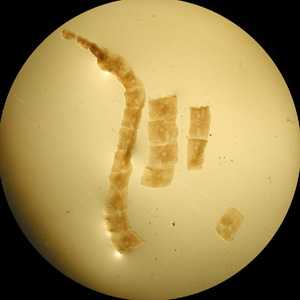
Case #232 - July, 2008
A study was conducted on herding dogs in a sheep-raising region of northeastern Arizona to determine the prevalence of Echinococcus granulosus. Public health officials wanted to determine the risk for hydatid cyst disease in the local people. Stool specimens from the dogs were collected and taken back to a laboratory for analysis. Figures A and B show objects recovered from the stool of several of the dogs. The objects varied in length from 10-13 centimeters and measured approximately 2 millimeters wide. What is your diagnosis? Based on what criteria?

Figure A

Figure B
Case Answer
These objects represented proglottids of a cestode in the genus, Mesocestoides. Although scoleces were not present in any of the specimens observed in this case, the presence of more than five proglottids, and the parallel-sided nature of the proglottids, indicated these objects did not represent an infection with E. granulosus. Diagnostic features for Mesocestoides included:
- genitalia single per segment.
- a lack of a uterine pore.
- a uterus consisting of a blind tube running adjacent to the midline of each segment (red arrow, Figure B).
- the presence of the ovary (blue arrow, Figure B) and parauterine organ (green arrow, Figure B).

Figure B
Mesocestoides is a genus of tapeworms parasitic in a wide range of mammalian and avian species. Mammal hosts include dogs, cats, skunks and rodents. Human infections have rarely been reported in the literature. Infection in humans usually results from the ingestion of viscera or blood containing the infective stage (tetrathyridium).
More on: Mesocestoidiasis
Images presented in the monthly case studies are from specimens submitted for diagnosis or archiving. On rare occasions, clinical histories given may be partly fictitious.
DPDx is an education resource designed for health professionals and laboratory scientists. For an overview including prevention and control visit www.cdc.gov/parasites/.
- Page last reviewed: August 24, 2016
- Page last updated: August 24, 2016
- Content source:
- Global Health – Division of Parasitic Diseases and Malaria
- Notice: Linking to a non-federal site does not constitute an endorsement by HHS, CDC or any of its employees of the sponsors or the information and products presented on the site.
- Maintained By:


 ShareCompartir
ShareCompartir